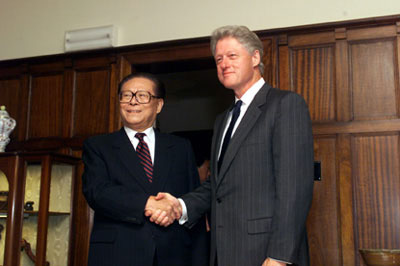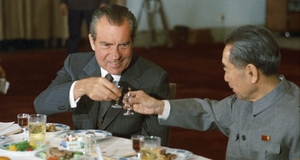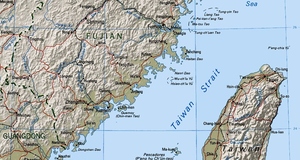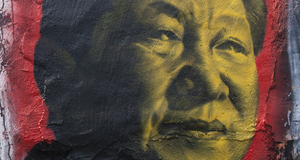From Cornell International Affairs Review VOL. 4 NO. 1The Same Bed: Articulating a Continuity Thesis in US-China Policy
IN THIS ARTICLE
KEYWORDS
This analysis of U.S.-China relations was motivated by what I perceived to be misplaced "controversy" over Obama's China visit in autumn 2009 and his subsequent policy initiatives, which despite all of the public scorn are really no different from those of previous administrations. The paper singles out a rarely-articulated coherent logic in the history of U.S. foreign policy towards China, one that I argue can also predict U.S. policy in the present and future. IntroductionIn a controversial and popularly cited 1999 Foreign Affairs article, Gerald Segal posed the question “Does China matter?” in response to growing international attention regarding China’s economic miracle over the preceding decade. Segal’s answer, “the Middle Kingdom is a middle power - China matters far less than it and most of the West think, and it is high time the West began treating it as such”1 resonates considerably less today; since then, both China and opinion regarding it have advanced significantly, giving rise to new fears and perceptions of U.S. foreign policy. In 2007, the Financial Times boldly suggested that “the era of American global dominance is coming to a close” and may be overtaken by China in about twenty years.2 Alarm over conciliatory policies in this newly perceived context is commonplace and unsurprising, as exemplified by the sharp criticism of Obama’s China policy in the wake of his state visit to Beijing last month. His critics in Congress, nongovernmental organizations and the general public bemoan that a hard line on China, rather than the open-handed approach of the Obama presidency and his compromising character, would fashion a tougher and ultimately safer stance on China for national security and prosperity. However, this common narrative belies the complex realities of the Sino- American relationship. It unfortunately makes up in popular appeal, by indulging in a public fearful of its national decline, what it lacks in a sound understanding of past and present U.S. political relations with China and the Far East. Despite journalistic and scholarly claims to the contrary over the years, current U.S. foreign policy regarding China follows in a long pedigree of bilateral relations that have, over the last two decades especially, formed and severely constrained the range of policy options available in the present day. The realities and complexities of this relationship effectively limit the influence that any one ideology or personality in power may have. In spite of the rhetoric of U.S. leaders and the much-publicised occasional “crises” that have marked the tumultuous nature of Sino- American diplomacy, this study argues that U.S. foreign policy towards China has not only exhibited remarkable continuity since and during the Cold War, but will continue to be unremarkably predictable in coming years. Rather, the perceived multiplicity of policy options is a misperception arising from the traditional and systemic conflict between Congress and the Executive over China policy. US-China Bilateral Relations: The Traditional Macro-HistoryIn traditional terms, the story of U.S. foreign policy towards the People’s Republic of China (PRC) is divided into two distinct periods – the Cold War and the period since the Cold War – with the latter exhibiting constant shifts in policy orientation both between and within presidential administrations. The détente with China orchestrated by Nixon and Kissinger in the 1972 Shanghai Communiqué opened nearly two decades of bilateral relations based on mutual strategic imperatives under a Cold War setting. By that time, after the discovery of Soviet troops in Cuba and the Soviet invasion of Afghanistan, U.S. – Soviet détente had ended and Washington was ever less sanguine about it reemerging. As the Soviet Union came to appear more ominous, China grew more valuable to the United States as a strategic ally. “It was clear,” notes Robert S. Ross, “that the United States now sought a ‘stable marriage’ so as to better contend with Soviet U.S. policy.”3 During this time, the U.S. and China cooperated strategically against their common enemy, and refrained from quarrelling over Taiwan as a result. The issue of human rights was likewise intertwined with strategic objectives, agrees Ming Wan, a Chinese historian: “Human rights in China was rarely mentioned by the government, the media or human rights NGOs in the United States throughout the 1970s and only incrementally in the 1980s…China was a ‘human rights exception’ even when the United States pursued an articulated global human rights policy.”4 From the perspective of U.S. foreign policy, the evidence amply supports this characterisation. China became increasingly opposed to U.S. arms sales to Taiwan after 1979 and instigated a round of negotiations that, as a characteristic and high-profile example, does well to reveal the nature of the U.S.-China relationship at the opening of the 1980s. When Washington attempted to moderate Beijing’s stand by balancing arms sales to Taiwan with arms sales to the PRC, Chinese leaders refused to buy U.S. arms and threatened further hostile action.5 The resulting 1982 Communiqué was a result of aggressive Chinese negotiation; although it did not promulgate a specific end to arms sales, it did bring China much closer to its ultimate goal by placing heavy restrictions on Washington’s arms policy. “The negotiating process,” observes Ross, “revealed… Washington’s fear that China would carry out its threat, thereby undermining the strategic relationship with China.”6 It was very much in Washington’s interest, both at the outset of China’s “opening” and towards the end of the Cold War, to play down the importance of the contentions including Taiwan and human rights, and push for Sino-American cooperation. But since the end of the Cold War, Sino-American relations have operated within a drastically altered international context requiring an equally distinct bilateral relationship. In the pivotal year of 1989, the collapse of communism in Eastern Europe and the brutal suppression of the Tiananmen protests dealt a dual blow to the U.S.-China rapport within the United States. Throughout the Cold War, the Chinese had stood, for America, at the forefront of reform in the communist world – “daring, innovative, and increasingly capitalist.”7 That it now stood at the turn of the decade as a lingering bastion of communism seen anew as corrupt and backwards in the wake of the Tiananmen massacre led to a profound disillusionment as the public turned away from China.8 The uneasy relationship in the early 1990s was accordingly characterised by Chinese distrust and American toughness, with central disputes over the trade imbalance, nuclear proliferation, and human rights. The conventional view, which is certainly validated to a significant extent, is that the United States found itself freed from self-restraint to criticise China over issues and controversies it had hitherto quelled. American grievances focussed on the huge US trade deficit as a result of the impenetrability of the Chinese market, its intellectual property infringements and deceptive foreign labelling, as well as the PRC’s sales of ballistic missiles to Syria, Pakistan and Iran. Criticism was most forceful in the aftermath of the Tiananmen protests in regards to religious tolerance in Tibet, as well as the upcoming transfer of Hong Kong to the PRC. China, on the other hand, insisted on the sovereignty of its nation with respect to internal matters, and argued the hypocrisy of U.S. criticism in regards to its arms policies, as the U.S. remained the world’s largest arms merchant. Of course, there were important agreements and compromises between the two countries during this time. Most famously, U.S. President Bill Clinton decided to “delink” the renewal of China’s Most Favoured Nation (MFN) status from human rights, as part of his administration’s mid-term adoption of the “Comprehensive Engagement” policy. Towards the end of his term, U.S. President Bill Clinton also initiated the negotiations that would shortly thereafter lead to China’s lauded accession to the World Trade Organisation. These “engagement” accomplishments and concessions towards the PRC, however, remain in the shadow of the 1995-1996 Taiwan Strait crisis, as well as the initial hard-line policy that Clinton campaigned under with regards to confronting China. Despite the advancement of the bilateral relationship, encyclopaedic accounts (which are useful for their professional impartiality and macro-positioning) of the 1990s U.S.-China relationship relegate them with respect to the squabbles and altercations that defined the uneasiness of the decade. “In the absence of the strategic imperative that the Cold War had supplied, such disagreements loomed larger and could not be resolved with the ambiguous compromises of earlier years,”9 the Encyclopedia of U.S. Foreign Relations points out in its entry on China. The picture of U.S. China policy in the decade following the Cold War thus becomes one of no recognisable pattern, alternating between containment and engagement, censure and praise, toughness and compromise, and even armed confrontation and peace. As a result of the tumultuous highs and lows of U.S. foreign policy towards China in the 1990s, the dominant appraisal becomes one of uncertainty. Indeed, for its closing statement, the encyclopaedia asserts that “as the end of the twentieth century approached, Sino- American relations once again only could be characterized as troubled and uncertain, weaker than at any time since rapprochement began.”10 Confronting and Refining the Traditional NarrativeThis is not a mistaken narrative; it is a simplistic one. It serves as a useful base from which to understand the evolution of U.S. foreign policy and the various approaches that have been tried by the George H. W. Bush, Bill Clinton, and George W. Bush presidencies since the end of the Cold War. Indeed, this paper neither refutes this account of the history of American China policy nor asserts that the current administration views it as such. However, it does contend that to take it for granted, as is often the case during foreign policy debate in the U.S., will inevitably lead to a misperception of current policy and perhaps influence the pursuit of unsound policy (or, as seems to be the case, undue critique of sound policy). The problem arises from the framing of the post-Cold War relationship as one in which the United States could finally pursue a policy guided by the full scope of its national interest. In this sense, it tends to see negotiation with China not as part of a pattern of rational strategy implementation, but rather as periodic concessions eroding what would otherwise promote U.S. interests more fully. However, beneath much of the rhetoric and public policy debates, U.S. presidents since the Cold War have rarely acted as suggested by their aggressive policy outlines. Patient and calculated negotiation with the PRC has, in fact, been the norm. Consider the actual policies of the last three presidencies. Although both Clinton and Bush campaigned under a tough China policy, both presidents quickly found it necessary to conduct an abrupt aboutface in policy as a result of the realities of the bilateral relationship. George H. W. Bush, for his part, although inaugurated during the Cold War, continued to be relatively accommodating towards China past 1989. During his presidency he maintained his support for unconditional MFN status and favoured a policy of engagement with China. Perhaps most relevantly, he tempered the U.S. government’s censure and sanctions following the Tiananmen massacre by secretly dispatching the emissaries Brent Scowcroft and Lawrence Eagleburger to China in order to assure the PRC that the U.S. was still keenly interested in maintaining good relations. Unsurprisingly, the eventual discovery of the mission led to a public uproar; in doing so, however, Bush continued in the tradition of his Cold War predecessors and set the precedent for overall warm relations with China in the post-Cold War period. ClintonPresident Bill Clinton campaigned for his presidency under a decidedly aggressive China policy, in fact placing himself in direct opposition to Bush. In 1992, Clinton condemned his predecessor’s China policy as too soft and vowed to get tough with China if elected to the White House. One year later, he announced his momentous decision to issue an ultimatum for the PRC to change its human rights practise in 12 months or face suspension of its MFN status.11 Yet, in 1994, Clinton reversed course, preaching instead a revised policy of “comprehensive engagement,” to the bafflement and suspicion of both American and Chinese onlookers. Nevertheless, he appeared committed throughout the rest of his presidency to the new policy. Chinese President Jiang Zemin soon visited the White house for the first time in Clinton’s presidency, and the U.S. president reciprocated by touring China in 1998. Notable negotiations of Clinton’s China policy include drawing the terms for China’s admission to the WTO, even while the administration wanted to reduce the nation’s trade deficit with China. He likewise issued permanent normal trade relation status to the PRC. As previously mentioned, these advancements accompanied Clinton’s abandonment of the annual renewal of China’s MFN status as a contingency of China’s human rights record, which had been a strong coercive incentive for reform within the PRC. Although economists and businesses were pleased, the policy infuriated a portion of the U.S. public, Congress, and activist organisations. The 1995-1996 Taiwan Strait crisis, which escalated dangerously to a show of arms between the two powers after the U.S. granted then-Taiwanese President Lee Teng-Hui an entry visa, stands as the most confrontational moment in Sino-Soviet relations since the Cold War. Notably, the conflict occurred over Taiwan, where U.S. leaders have traditionally been most aggressive. Even more important, however, is the response that the crisis elicited from Clinton’s administration. Although Ross makes clear that Clinton’s bold move to “allow Taiwan’s most senior leader to enter the United States reversed more than twentyfive years of U.S. diplomatic precedent,”12 the president’s subsequent actions convey an urgent desire to mend relations, much as President Bush had displayed in the aftermath of the Tiananmen Square protests. During a tour in China in 1998, Clinton not only coined China a “strategic partner,” but also stated the “Three No’s” to Taiwan: that America would not support Taiwanese independence, two Chinas, or Taiwanese membership in the United Nations. Moreover, it appears that all subsequent Taiwanese presidents have been only been issued visas for layovers as they are passing through the United States on their way to Latin America.13 Nearly all of Clinton’s policy enactments under his engagement strategy, largely regarded today as fundamental progress in bilateral relations and China’s constructive emergence, elicited controversy at the time. To downplay the criticism he received by hard-liners who felt betrayed by his change of strategy, Clinton’s rhetoric stressed the generally prevailing notion that increased economic integration and interdependency would eventually lead to demands for political reform within China. BushPresident George W. Bush assumed office in the same manner as Clinton eight years earlier. Regarding Chinese expansionary interests as a threat to U.S. hegemony, he negated the unifying effects of Clinton’s words during his 1998 China tour by stating that China was not America’s strategic partner, but instead a “strategic competitor.” As Andrei Davydov broadly summarises, “Vice President Cheney, Defense Minister Donald Rumsfeld, and their departments believed that a policy, if not of deterrence, at least of active constraint should be carried out regarding China, which presumed expanding America’s military presence in Asia, increasing political and military assistance to Taiwan, strengthening political relations with countries allied and friendly with the U.S., and treating China as a potential strategic adversary.”14 In line with this reorientation in foreign policy, the president’s harshest statement was delivered on 25 April during an impromptu interview on ABC’s Good Morning America, where he affirmed for the first time in U.S. history that if Taiwan were attacked, the U.S. would do “whatever it took”15 to defend the island. In so doing, the president was effectively declaring that the U.S. was abandoning the “indeterminate strategy”16 it had pursued for decades regarding a possible attack on Taiwan. Bush retracted his statement later that afternoon during an interview with CNN, subtly returning to the status quo position of Clinton’s presidency. The message to the PRC, however, remained unsettling. The Bush administration complemented its aggressive military tone with various diplomatic affronts, including an invitation to the Dalai Lama. Chi Wang, author of George W. Bush and China, reveals that “apart from being confrontational, Bush’s China policy also appeared contradictory” – for instance, by announcing major shifts in China policy only to retract the statements, on several occasions.17 The contradictory nature of President Bush’s foreign policy serves to underscore the naivety of a new administration as yet unfamiliar with the history of the bilateral relationship. As Wang makes clear in her investigative work, one explanation is that the Bush administration contained “no senior-level officials with any significant amount of China experience.”18 Although it is difficult to tell at what point in the Bush presidency the administration would have softened its tone towards the PRC, the terrorist attacks of September eleventh, 2001 provided a premature impetus for a complete reorientation of China policy. Vice President Cheney, Defense Minister Donald Rumsfeld and their departments believed that a policy...at least of active constraint, should be carried out regarding China, which presumed...treating China as a potential strategic adversary. Recognising the need for China’s cooperation in combating international terrorism and the nuclear threat in North Korea, the Bush administration rapidly resumed a cooperative tone and frequent visits in order to emphasise the two nations’ common ground. The resulting China policy over the ensuing seven years followed, as a result, from this sentiment and from prior administrations’ approach. Proposing a “constructive, cooperative, and candid”19 relationship with the PRC, Bush made an unprecedented two visits to China within a half-year after September 11, 2001. A third summit meeting took place at the Bush family ranch in Texas in 2002, signifying the highest frequency of meetings between the top leaders of the U.S. and China in history.20 In June 2004, the White House pressured the Pentagon to cancel Major-General John Allen’s visit to Taiwan. That December, as Chinese Premier Wen Jiabao was visiting the U.S., Bush issued a statement about Taiwan’s ambitions for independence by saying, “The comment and actions made by the leader of Taiwan indicate that he may be willing to make decisions unilaterally to change the status quo, which we oppose.”21 Regarding the issue, Wang writes that “while the previous U.S. administration had very deliberately taken no position on the matter of sovereignty over Taiwan, Dennis Wilder, a senior Bush aide, said during his trip with the president to the April 2007 Asia- Pacific Economic Cooperation Summit that ‘Membership in the United Nations requires statehood. Taiwan is not at this point a state in the international community.’”22 While making these concessions, the Bush administration simultaneously continued the Clinton initiative to bolster its forces in the Pacific, particularly in order to respond quickly to any threat made on Taiwan. Besides expanding the number of aircraft carriers, battleships, and missile submarines in the Western Pacific, the Bush administration also fostered closer military ties with Taiwan by facilitating communication and training. Such military preparedness in the region is vital to Washington’s interests, as it had been under the last two administrations. The China policy of President Bush, then, despite its initial confrontational stance and aggressive tone, followed from that of Presidents Clinton and his father before him. Cooperation and engagement with the PRC was seen as a vital diplomatic necessity, all the while ensuring the independence of Taiwan from an undue Chinese attack.Continued on Next Page » Suggested Reading from Inquiries Journal
Inquiries Journal provides undergraduate and graduate students around the world a platform for the wide dissemination of academic work over a range of core disciplines. Representing the work of students from hundreds of institutions around the globe, Inquiries Journal's large database of academic articles is completely free. Learn more | Blog | Submit Latest in International Affairs |




















